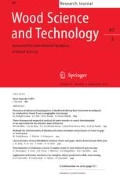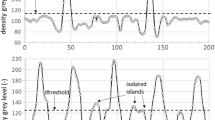Abstract
The material point method (MPM) was used to numerically model pressure-driven flow of adhesive into hybrid poplar wood. The cellular structure of the hybrid poplar was discretized in an MPM model by converting X-ray computed tomography (XCT) voxels from 3D scans of actual wood–adhesive bond lines into material points in the model. In the MPM model, a slab of adhesive between two wood adherends was forced into the modeled wood structure. The wood material was modeled as a rigid material and the adhesive as a compressible, non-Newtonian fluid. MPM is well suited for these simulations because it can handle the large deformation of the adhesive fluid as well as adhesive–wood contact. The MPM fluid model with contact was verified by 2D simulations of a geometry with a known analytical solution using the same parameters and resolution as the full 3D simulations. Multiple 3D simulations were run, and the modeled adhesive penetration at the end of the simulations was compared to experimental penetration observations in the source XCT data. The simulation results correlated well with experimental results.











Similar content being viewed by others
References
Aimene YE, Nairn JA (2015) Simulation of transverse wood compression using a large-deformation, hyperelastic–plastic material model. Wood Sci Technol 49:21–39. https://doi.org/10.1007/s00226-014-0676-6
Bardenhagen S, Guilkey JE, Roessig K, Brackbill J, Witzel W, Foster J (2001) An improved contact algorithm for the material point method and application to stress propagation in granular material. CMES Comput Model Eng Sci 2(4):509–522
Bardenhagen SG, Kober EM (2004) The generalized interpolation material point method. Comput Model Eng Sci 5:477–496
Basafa E, Murphy RJ, Kutzer MD, Otake Y, Armand M (2013) A particle model for prediction of cement infiltration of cancellous bone in osteoporotic bone augmentation. PLoS ONE 8(6):1–10
Brackbill J, Kothe D, Ruppel H (1988) FLIP: a low-dissipation, particle-in-cell method for fluid flow. Comput Phys Commun 48(1):25–38
Brackbill JU, Ruppel HM (1986) FLIP: a method for adaptively zoned, particle-in-cell calculations of fluid flows in two dimensions. J Comput Phys 65(2):314–343
Brydon AD, Bardenhagen SG, Miller EA, Seidler GT (2005) Simulation of the densification of real open-celled foam microstructures. J Mech Phys Solids 53(12):2638–2660
Gascón L, García JA, LeBel F, Ruiz E, Trochu F (2016) A two-phase flow model to simulate mold filling and saturation in resin transfer molding. Int J Mater Form 9(2):229–239
Gibson LJ, Ashby MF (1982) The mechanics of three-dimensional cellular materials. Proc R Soc Lond Ser A Math Phys Sci 382(1782):43–59
Graf J (2016) PID control fundamentals. Createspace Independent Publishing Platform. https://books.google.com/books?id=kMoEvgAACAAJ. Accessed Sept 2017
Hamad F, Wieckowski Z, Moormann C (2017) Interaction of fluid–solid-geomembrane by the material point method. Comput Geotech 81:112–124
Hammerquist CC, Nairn JA (2017) A new method for material point method particle updates that reduces noise and enhances stability. Comput Methods Appl Mech Eng 318:724–738
Hu P, Xue L, Mao S, Kamakoti R, Zhao H, Dittakavi N, Ni K, Wang Z, Li Q (2010) Material point method applied to fluid–structure interaction (FSI)/aeroelasticity problems. In: 48th AIAA aerospace sciences meeting including the new horizons forum and aerospace exposition, Orlando Florida. American Institute of Aeronautics and Astronautics
Isoldi LA, Oliveira CP, Rocha LA, Souza JA, Amico SC (2012) Three-dimensional numerical modeling of RTM and LRTM processes. J Braz Soc Mech Sci Eng 34(2):105–111
Jiang C, Schroeder C, Teran J (2017) An angular momentum conserving affine-particle-in-cell method. J Comput Phys 338:137–164
Li YH (1967) Equation of state of water and sea water. J Geophys Res 72(10):2665–2678
Mendoza M, Hass P, Wittel FK, Niemz P, Herrmann HJ (2012) Adhesive penetration of hardwood: a generic penetration model. Wood Sci Technol 46(1):529–549
Michaud V (2016) A review of non-saturated resin flow in liquid composite moulding processes. Transp Porous Media 115(3):581–601
Mortensen A, Cornie JA (1987) On the infiltration of metal matrix composites. Metall Mater Trans A 18(6):1160–1163
Nairn JA (2006) Numerical simulations of transverse compression and densification in wood. Wood Fiber Sci 38:576–591
Nairn J (2013) Modeling imperfect interfaces in the material point method using multimaterial methods. Comput Model Eng Sci 1(1):1–15
Nairn JA (2016) Material point method (NairnMPM) and finite element analysis (NairnFEA) open-source software. http://osupdocs.forestry.oregonstate.edu/index.php/Main_Page. Accessed Sept 2017
Nairn JA, Hammerquist CC, Aimene YE (2017) Numerical implementation of anisotropic damage mechanics. Int J Numer Methods Eng. https://doi.org/10.1002/nme.5585
Nairn JA, Bardenhagen SG, Smith GS (2018) Generalized contact and improved frictional heating in the material point method. Comput Part Mech 5(3):285–296
Oliveira I, Amico S, Souza J, Lima A (2016) Resin transfer molding process: a numerical and experimental investigation. Int J Multiphys 7(2):125–136
Paris JL, Kamke FA (2015) Quantitative wood–adhesive penetration with x-ray computed tomography. Int J Adhes Adhes 61:71–80
Paris JL, Kamke FA, Nairn J, Muszyński L, Schwarzkopf M (2013) Wood–adhesive penetration: non-destructive, 3d visualization and quantification. In: Frihart CR (ed) Proceedings of the international conference on wood adhesives, Toronto, ON. Forest Products Society
Paris JL, Kamke FA, Mbachu R, Gibson SK (2014) Phenol formaldehyde adhesives formulated for advanced x-ray imaging in wood-composite bondlines. J Mater Sci 49(2):580–591
Paris JL, Kamke FA, Xiao X (2015) X-ray computed tomography of wood–adhesive bondlines: attenuation and phase-contrast effects. Wood Sci Technol 49(6):1185–1208
R Core Team (2016) R: a language and environment for statistical computing. R Foundation for Statistical Computing, Vienna, Austria. https://www.R-project.org/. Accessed Sept 2017
Raymond S, Aimene Y, Nairn J, Ouenes A, et al (2015) Coupled fluid–solid geomechanical modeling of multiple hydraulic fractures interacting with natural fractures and the resulting proppant distribution. In: SPE/CSUR unconventional resources conference, Society of Petroleum Engineers
Ross RJ, USDA Forest Service FPL (2010) Wood handbook: wood as an engineering material. USDA Forest Service, Forest Products Laboratory, General Technical Report FPL- GTR-190. https://books.google.com/books?id=v0whAAAAMAAJ. Accessed Sept 2017
Sulsky D, Chen Z, Schreyer H (1994a) A particle method for history-dependent materials. Comput Methods Appl Mech Eng 118(1):179–196
Sulsky D, Chen Z, Schreyer HL (1994b) A particle method for history-dependent materials. Comput Methods Appl Mech Eng 118:179–186
Upton B, Miner R, Spinney M, Heath LS (2008) The greenhouse gas and energy impacts of using wood instead of alternatives in residential construction in the united states. Biomass Bioenergy 32(1):1–10
Wilkes J (2006) Fluid mechanics for chemical engineers with microfluidics and CFD. Prentice Hall International Se, Prentice Hall Professional Technical Reference
Acknowledgements
Financial support was provided by the Wood-Based Composites Center, a National Science Foundation Industry/University Cooperative Research Center (Award 1624599-IIP).
Author information
Authors and Affiliations
Corresponding author
Additional information
Publisher's Note
Springer Nature remains neutral with regard to jurisdictional claims in published maps and institutional affiliations.
Rights and permissions
About this article
Cite this article
Hammerquist, C.C., Nairn, J.A. Numerical simulation of pressure-driven adhesive penetration into realistic wood structures. Wood Sci Technol 52, 1271–1288 (2018). https://doi.org/10.1007/s00226-018-1032-z
Received:
Published:
Issue Date:
DOI: https://doi.org/10.1007/s00226-018-1032-z




